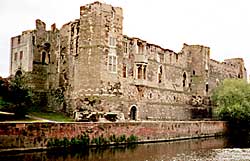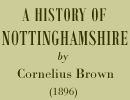< Previous | Contents | Next >

The Chantry on Appletongate was built in the fourteenth century and demolished in the 18th century and replaced by a Queen Anne style house: the site is now occupied by the Palace Theatre.
Opening upon the same thoroughfare called Appleton Gate, was another large religious house for the accommodation of the chantry priests, which has ever since retained the name of the Chauntry. No less than fourteen chantries were founded at Newark, and the mansion-house was established by Widow Alice Fleming, so that the priests might associate together. The Rev. F.J Dimock says:
We might search through all England, and should find few indeed, if any, parish churches which could boast such an array of chantries as Newark possessed in the fourteenth and fifteenth centuries.'
During the Wars of the Roses Newark was the scene of warlike demonstrations, and Edward IV. passed through the town on his way to combat the wearers of the Red Rose gathered at Doncaster. His Majesty was 'worshipfully accompanied' to the Castle, and there marched through the streets of Newark so many 'goodly men well arrayed' that it was said the like had not been seen in England before. The rebels did not care to risk an encounter with this powerful host, and retired towards Manchester. In October, however, a strong contingent of them, headed by the Duke of Exeter, Lord Bardolph, and others, assembled at Newark, and occupied the town for some days. Edward started with such forces as he could control to meet his enemies, but they did not tarry until his arrival. The Duke of Exeter deemed it prudent to unite with the larger army of the Earl of Warwick, and to await battle in a more promising locality. Eventually the contending forces met at Barnet, and the result was the overthrow of the warriors who had lodged at Newark, and the triumph of the White Rose. But the bitter feelings to which so much fierce contention had given rise between the partisans of the rival houses did not die out at Barnet. It smouldered in a multitude of breasts until 1485, when it burst into a flame on Bosworth Field, and the last embers of it ignited the outbreak in 1487 in favour of Lambert Simnel, which came to an inglorious close at Stoke, near Newark.

The west front of Newark Castle. After the surrender of the town Parliament ordered the slighting of the castle. A survey of the manor of Newark in 1649 recorded that the castle was "soe Ruined that it will never be made habitable, havinge nothinge left but Ruinous pieces of Walls, which if they were pulled downe as they are fitt for nothing else ... we value the Freestone upon the place and other materials to be worth £100 and the grounds and soile whereon the said Walls Lands and rubbish lyeth being cleared therefrom and levelled will be worth per Annum twenty shillings". (A. Nicholson, 1995).
Proceeding along the centuries over which the annals of Newark extend, we cannot do otherwise than briefly refer to the visit of the great Cardinal Wolsey in 1530. The chancel of the church, one of the largest and most beautiful in England, was completed in 1487, and, without doubt, the famous prelate would officiate in it, as was his wont to do at the churches in the towns through which he passed. Two Newark worthies won the esteem of the rich Cardinal. Robert Brown, Alderman of Trinity Guild and Constable of the Castle, was his confidential adviser and receiver. He it was who introduced his neighbour, Thomas Magnus, to the notice of the Archbishop, and both of these men, Brown and Magnus, were munificent benefactors to the town, the latter having established the Grammar School, with which was also incorporated a school for teaching singing.
A few years after Wolsey's visit the Lincolnshire rebellion caused a great sensation in the district, and the Vicar of Newark, Henry Lytherland, became so involved in the subsequent disturbances under Robert Aske, that he was convicted of high treason in 1538, and sentenced to death. Some details of his trial are given in the State Papers.
During Elizabeth's reign large bodies of troops stayed at Newark on their way to suppress the rebellion in 1569, and the castle had at times several eminent occupants—notably, the great Lord Burleigh, whose son William was baptized there in 1591, and Gilbert, Earl of Shrewsbury, who wrote poetry at Newark in 1594.
